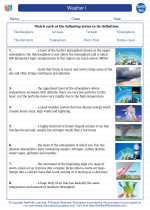Waves in Earth Science
Waves are a fundamental concept in Earth Science and are essential for understanding various natural phenomena such as sound, light, and seismic waves. In the context of Earth Science, waves can be broadly categorized into mechanical waves, which require a medium to propagate, and electromagnetic waves, which can travel through a vacuum.
Types of Waves
There are several types of waves, including:
- Transverse Waves: In transverse waves, the particles of the medium move perpendicular to the direction of the wave. Examples of transverse waves include light waves and the motion of the ocean surface waves.
- Longitudinal Waves: Longitudinal waves involve the particles of the medium moving parallel to the direction of the wave. Sound waves are a common example of longitudinal waves.
- Surface Waves: Surface waves are a combination of transverse and longitudinal waves, and they propagate along the boundary between two different mediums. Seismic waves, which are responsible for earthquake propagation, are an example of surface waves.
Wave Properties
Waves have several important properties, including:
- Amplitude: The maximum displacement of a wave from its equilibrium position. In the case of sound waves, amplitude determines the loudness of the sound, while in light waves, it affects the brightness of the light.
- Frequency: The number of complete wave cycles that pass a certain point in a given time. Frequency is measured in hertz (Hz) and is inversely related to the wavelength of the wave.
- Wavelength: The distance between two consecutive points of a wave that are in the same phase. For example, in sound waves, shorter wavelengths correspond to higher-pitched sounds, while longer wavelengths correspond to lower-pitched sounds.
- Speed: The rate at which a wave travels through a medium. The speed of a wave is determined by the properties of the medium through which it is traveling.
Wave Behavior
Waves exhibit various behaviors as they interact with different mediums and obstacles. Some key behaviors include:
- Reflection: The bouncing back of a wave when it encounters a boundary or obstacle. This is commonly observed in sound waves reflecting off walls and light waves reflecting off mirrors.
- Refraction: The bending of a wave as it passes from one medium to another, caused by a change in its speed. This phenomenon is visible when light waves pass through a prism and change direction.
- Diffraction: The bending of waves around obstacles and the spreading of waves as they pass through narrow openings. Diffraction is responsible for phenomena such as the spreading of sound waves around corners and the interference patterns observed in light waves.
Study Guide
To effectively study the topic of waves in Earth Science, consider the following key points:
- Understand the difference between mechanical and electromagnetic waves, and be able to provide examples of each type.
- Learn the properties of waves, including amplitude, frequency, wavelength, and speed, and how they are related to wave behavior.
- Explore real-world applications of waves, such as the use of seismic waves in earthquake studies and the role of light waves in astronomy.
- Practice solving problems related to wave properties, such as calculating frequency or wavelength based on given information.
- Experiment with wave behavior using simple setups, such as observing the reflection of sound waves or the diffraction of light waves through a narrow slit.
By mastering the concepts and applications of waves, you'll gain a deeper understanding of their significance in Earth Science and the broader natural world.
[Waves] Related Worksheets and Study Guides:
.◂Earth Science Worksheets and Study Guides High School. Weather I
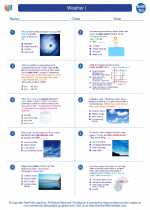
 Worksheet/Answer key
Worksheet/Answer key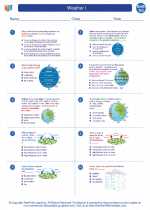
 Worksheet/Answer key
Worksheet/Answer key
 Worksheet/Answer key
Worksheet/Answer key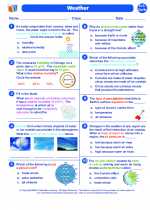
 Vocabulary/Answer key
Vocabulary/Answer key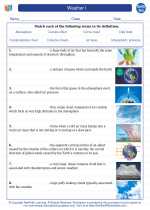
 Vocabulary/Answer key
Vocabulary/Answer key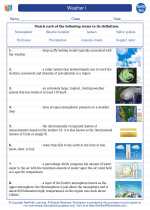
 Vocabulary/Answer key
Vocabulary/Answer key